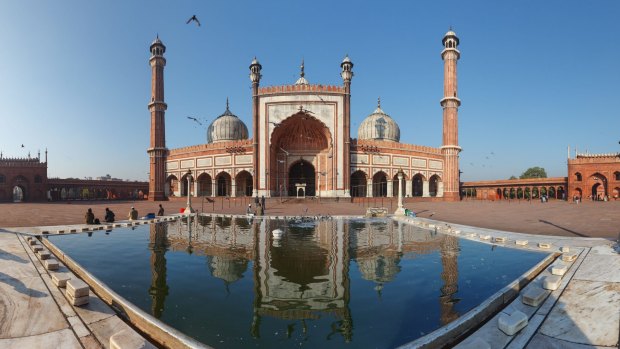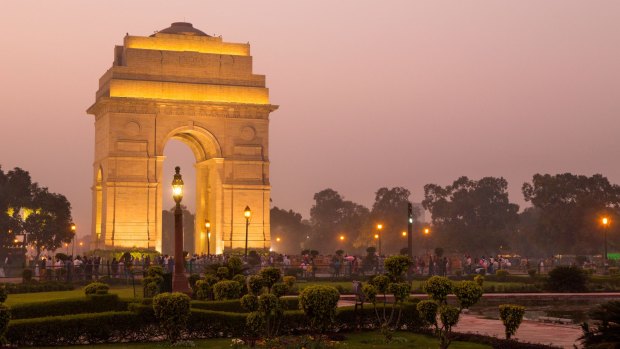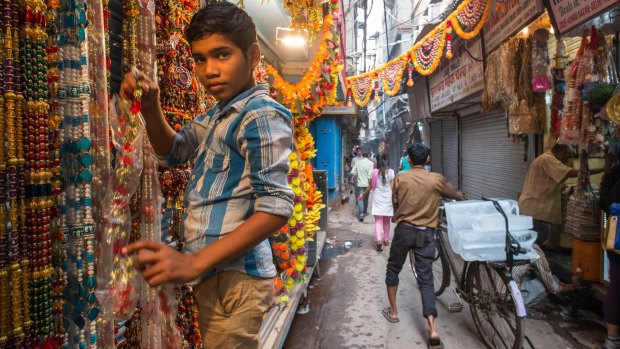This was published 5 years ago
Delhi, India, travel guide and things to do: The three-minute guide

Jama Masjid mosque in Delhi. Credit: Alamy
WHY
It's by no means a cliche to describe Delhi as truly a tale of two cities, or, to be more precise, a tale of two cities in one. The capital of India is, after all, divided between a modern planned and green city and an ancient, dauntingly chaotic but absorbing one. New Delhi was designed in the early part of the 20th century by the British architect Edwin Lutyens at the height of the British Raj. Distinguished by its generous open spaces, it's a profound contrast to Old Delhi, the origins of which can be traced to at least the 6th century BC. Together these two parts of a sum are the sprawling home to 18 million souls.
VISIT

India Gate illuminated at twilight.Credit: Alamy
Although New Delhi (delhitourism.gov.in) is interesting enough, especially for those for whom colonial modernist architecture and early 20th century urban planning appeals, the essence of the city exists in Chandni Chowk, Old Delhi's labyrinthine network of bazaars and laneways. It's here that much of the city's kaleidoscope of everyday commerce is conducted. It's best visited, especially for first-timers, in the company of an experienced private tour guide who can help you negotiate the mayhem of its crowded streets and escort you inside its endless (and dusty) nooks and crannies, including rooftops of decrepit buildings. It's from such vantage points that you can observe not only the fevered activity below but also the setting for a popular pastime where locals compete to sever the string on each other's kites.
MUST
Delhi, being the capital as well as an ancient city, is home to a plethora of important buildings but few are more significant than Red Fort and Jama Masjid. Both buildings date to the 17th century and were built in the distinctive local redsandstone. Jama Masjid, one of South Asia's biggest mosques, dominates its corner of Old Delhi with its towering minarets. Elsewhere, Red Fort is located right on the edge of Chandni Chowk's perpetually gridlocked main thoroughfare and extending over more than 100 hectares, was for two centuries the home of Mughal dynasty emperors until its seizure in 1856 by the British. These two sights can be visited as part of a full or half-day private guided tour of Chandni Chowk.

Old Delhi's labyrinthine network of bazaars and laneways can be traced back to the 6th century BC.Credit: Alamy
LOOK
One of Delhi's most imposing modern artworks presents itself not in the heart of the capital itself but on arrival inside Terminal 3 at the city's impressive Indira Gandhi International Airport (newdelhiairport.in), which opened in 2010, a model of modern India. The installation is a 100 metres long by 30 metres high sculpture comprised of series of mudras, or traditional ritual hand-gestures. It's arresting enough to stop many an airline passenger in the tracks of their four-wheeled luggage as they pass through main public areas of the airport.
EAT
In the thick of the captivating chaos of Chandni Chowk is an oasis in the form of Haveli Dharampura (havelidharampura.com). A grand mansion, or haveli, dating to the late 19th century, the complex has been rescued from decay and transformed after six years of painstaking restoration into a hotel and restaurant. Even if you can't stay in one of the 28 rooms, do reserve a table for lunch or dinner at one of the two restaurants, one overlooking a gorgeously ornate courtyard, and the other on the rooftop. The skilful modern Indian dishes on the degustation menus are superb.
SLEEP
Among the best museums and galleries is one located not in a stuffy institutional building but in the luxurious and stately confines of a five-star quasi-art deco hotel opened in 1936. The public spaces of the Imperial New Delhi (theimperialindia.com) are adorned with a huge collection of colonial and post-colonial art and it was here that the fateful negotiations for the post World War II partitioning of India were conducted between Mahatma Gandhi and Lord Louis Mountbatten. The service can be slightly haughty but amid the hotel's splendour, which extends to some tranquil and manicured grounds, it's a mere quibble.
TIP
It's true that Delhi air quality is appalling and at times it ranks as the worst in the world. Yet, aside from a few coughs and sneezes, a visit of a few days is usually more than endurable.
Anthony Dennis travelled to India as a guest of the Classic Safari Company and Singapore Airlines. See classicsafaricompany.com.au; singaporeair.com
Sign up for the Traveller Deals newsletter
Get exclusive travel deals delivered straight to your inbox. Sign up now.